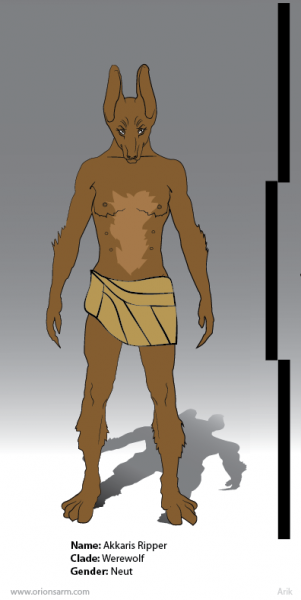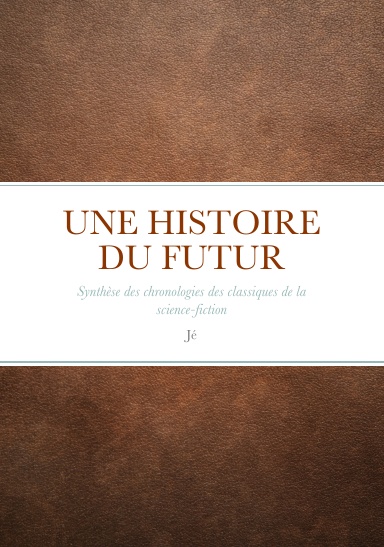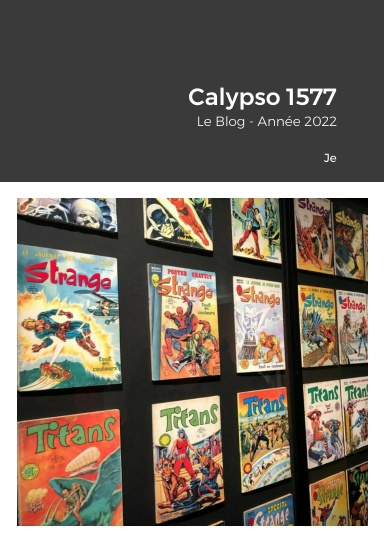 Werewolves are an ancient example of pseudolazurogenics based on mythological and folkloric shapeshifters. These rianths
are distinguished by a lupine physiology, created in part by
incorporating DNA from canine sources into the host genome. Historians
generally agree Werewolves were the first example of a true rianth clade
capable of endogamy.
Werewolves are an ancient example of pseudolazurogenics based on mythological and folkloric shapeshifters. These rianths
are distinguished by a lupine physiology, created in part by
incorporating DNA from canine sources into the host genome. Historians
generally agree Werewolves were the first example of a true rianth clade
capable of endogamy.There is evidence of Nekomimi modifications that predated the development of Werewolves, but these early catgirl genemods were individualistic and for the most part not compatible. Werewolves became a quick growing fad in the 130s a.t. following the popularity of Donna Mather's Pack Attack Tetralogy. The genemod's development took advantage of new progress in animal cross-species gene-splicing that had occurred over the previous decade. Gene therapies for medical therapies and enhancements had become acceptable over the past century for many cultures; however voluntary genemods used for purely superfluous alterations continued to remain a controversial topic. Morphological freedom was not a universally accepted human right, in the most severe cases Werewolves were ostracized or run out of town. This attitude drove many Werewolves to gather in minority neighborhoods that were historically sympathetic to their plight. Before the Technocalypse, the largest communities of Werewolves in SolSys were established in London, Paris, New York City, Mexico City, and Tokyo.
The first generation of Werewolves used a combination of germline modifications and prosthetics to emulate the look of classical werewolves. By the second generation a genemod standard had been decided on, and continued advances in gengineering allowed for the physiology to be further refined. Several centuries after being first established the werewolf standard was adjusted for breed specific traits in dogmen.
Since these early beginnings, most Werewolf clades have resisted all but the most conservative of bodymods. One option that first became available during the First Federation, is a shapeshifting ability to switch between a lupine state and a more baseline human state. This process can either be consciously triggered or cycled based on an external trigger. The shapeshifting is limited in scope, with the most dramatic changes occurring in the integumentary system and to a lesser extent the musculoskeletal system. Other organ systems like digestive and respiration remain unaffected. The process is energy intensive and requires a tripling of daily average caloric intake. Depending on the extent of shapeshifting taking place, an individual can complete the transition in about fourteen days.
Individuals from Werewolf clades that lack the ability of repeatable shapeshifting are nearly indistinguishable from baseline humans developmentally until they reach puberty. Once this stage is reached a number of physical changes take place. The maxilla and nasal bones are extended and widened into a proper snout. The canine teeth are enlarged and premolars are adapted to carnassial teeth to adjust to a predominantly carnivorous diet. The fingernails and toenails are modified into claws, and in some clades the shoulders and hips are modified to support efficient quadrupedal locomotion. Their strength is boosted by increases in muscle mass and muscle fiber density per square centimeter. A layer of fur is formed by an induced hypertrichosis, producing thick terminal and fine vellus hair. Further modifications deal with the sensory system, hearing and olfactory, and digestive system.
As with many early genemods, the standard Werewolf genemod had unforeseen complications. The combination of the changes in diet and neurobiochemistry has resulted in a high incidence rate of Werewolves suffering from episodes of melancholia and manic depression. A workaround to this defect has been known since the early 4th century a.t., however even with this cure many purists refuse to adopt the changes and instead have modified their lifestyle. These psychological symptoms are now well known to be caused by environmental factors, and can be minimized through avoidance. This misunderstanding of occasional foul moods by outsiders has reinforced the pack lifestyle of close connection to family and friends.
Image from Steve Bowers
|


















9 commentaires:
Pseudolazurogen (noun); pseudolazurogenic (adj.)
The reconstruction of a mythical creature from Old Earth Folklore using the procedures used in lazurogenics. Particularly popular are various species of dragon, which can be derived from heavily modified crocodile or avian genes.
Other pseudolazurogens include the Bigfoot, Yeti, Seamonster, basilisk, chimera and chupacabra. Particularly widespread are vampires and werewolves, based on classical horror/folktales.
Clade Cromag is a classic example of a pseudolazurogenic prim human species, based on ancient misconceptions about early humans.
Humans engineered to have certain characteristics of other animals
The term Rianth is derived from Greek, therianthrope, and was first used in the Interplanetary Age. It describes a person or clade of human derivation that has technologically altered their body to express physical, mental and social traits found in other naturally evolved species, usually animals. Some distinguish between rianths who have incorporated the traits of provolves and those who show the traits of baseline animals. The distinction between rianths and splices is more social and historical than biological. Unlike the splices, who have often had a history of domestication and service employment (in large part due to the majority of splices being non-sophont, animal workers/pets), rianths have more typically had complete autonomy and were not slaves but free citizens at their time of origin. They are baseline or nearbaseline humans who chose to acquire nonhuman traits and make them heritable, or whose human parents made that choice for them. [...]
Genemod
Genetic modification. Can be somatic (designed not to be heritable), germline (capable of being inherited by offspring) or both. Genemods are designed to alter a bionts body at a fundamental level, "reprogramming" their capabilities and responses to the environment. Major genemods that seek to significantly alter tissue, organ or whole body function often are constructed with iterative steps that guide relevant cell clusters through appropriate growth and redevelopment. In the modern era applying a genemod is an easy process; it can either be uploaded into one's medisystem or downloaded to a genestick so that it may synthesise appropriate augmentive nanites.
Most genemods today are genomically modular and are carefully labelled to ensure a compatibility test is run with the user's genome, before allowing insertion. Even so, it is advisable to ensure one's genome is backed up and to consult an autodoc, even when using reputable brands.
Technocalypse
History of the civilisation collapse that befell Earth and the Solar System in the Late Interplanetary Era. The Technocalypse is known by many other popular names, including the Nanodisaster, the Technocrash, and the Swarms as well as more technical terms such as the Cascading Complexity Collapse.
Source : https://orionsarm.com/eg-article/559d3b5ae17aa
Solsys
Solsys (The Old Solar System): The original system of Humanity and the origin of Terragen Civilisation
Planets, Moons, and Other Bodies
Helios A, B, and C: Intra-Mercury Orbital bands. Population 450 million; mostly ais and virtuals, with a small number of vecs, cyborgs, animants, sun miners.
Mercury: Small, rocky history-rich world, non-terraformed. Population 20 million, mostly ais, vecs, cyborgs, Sun Miners. Orbitals population about 50 million, mostly ais and virtuals.
Venus: Recently terraformed and with a surface population now at several billion, it is currently the most populated world in the inner system. Orbital population about 1 million, mostly ais, cyborgs, vecs, To'ul'h, and To'u'lhuman.
Earth: The domain of the Archailect GAIA, and the original world of Terragens.
Luna: The oldest permanent colony in the Terragen Civilisation.
Cis-Lunar Space: The Earth-Moon system is a major tourist
attraction and also the administrative center, home to 2 billion bionts.
Here are the major orbital habitats such as the ancient Roddenberry and
even a reconstruction of Island One, the pilgrimage sites among the Lunar
cities, and various Earth-orbit hotels where the curious can watch the
origin of mankind. The Solar Organisation and Institute of Human
Archaeology is housed at New Academeion.
Mars: The current Mars Republic is the oldest continuous government in the Solar System. However it is much more decentralised than the original Republic, and most regions and habitat-states are fairly autonomous. Present population is approximately 900 million sophonts.
The Asteroid Belt: A diverse, well populated, and history-rich part of SolSys, with an overall population about 160 billion, belonging to every conceivable race, species, and clade.
Ceres: The largest asteroid in the Belt, now paraterraformed.
Jupiter: Like the Belt, the Jupiter system, with its myriad of moons, trojans, orbitals and bubblehabs is quite populous and often visited by tourists, mainly ancestry-interested tweaks looking for the history of the Gengineering Republic and the early Genetekker Culture.
Io: Currently no permanent presence on the surface. About 250,000 scientists, artisans, and tourism workers in the four orbitals.
Europa: Long believed to be a habitable home for life, Europa excited great interest during the Information and early Interplanetary Age. The predicted inner ocean was found to exist under the massive ice sheets, but turned out to be quite lifeless until the engineering of the Europans and their supporting ecosystem.
Ganymede: The moon is home to half a dozen fairly large tweak polities, and a number of smaller states.
Callisto: The huge crowds and crush of populace are now long gone, and the major arcologies and habitats on and beneath the surface now are given to a flourishing tourist trade, entertainment, the arts, virchistorical tours and totalrecalls, a Genetekker revivalist colony and, in some areas, a rather flourishing red light industry.
Saturn: The glorious rings of Saturn were gradually removed by miners and momentum generation systems; recently several small moons have been artificially pulverized in an effort to replace them for the tourist industry. The bubblehabs in its atmosphere, some dating back to before the Technocalypse, are of particular historical interest, as Saturn was the recipient of many human refugees during the Great Expulsion and was a rich centre of development in the late Dark Ages and early Federation times.
Titan: A major tourist destination for Cishps and Titan derived clades as well as the Muuh, who inhabited the moon millions of years in the past. The large cities and impressive ecology of the subsurface of ocean are major attractions too.
Enceladus: Site of the first experiment in Geoflex Computing.
Uranus: Currently the inhabitants are affiliated to a greater or lesser degree with the Solar Organization.
Neptune: Currently Neptune and its many atmospheric and orbital settlements are integrated to one degree or another with the Solar Organization.
Kuiper Belt: Currently the Kuiper Belt and its many settlements are integrated to one degree or another with the Solar Organization.
Pluto: In the Current Era, an increasing number of Plutonians have expressed interest in expanding the role of the OSDA or possibly leaving the Solar Organization altogether but no concrete actions have been taken to date.
Mary: Kuiper Belt object. Home to the ancient Marian clade.
Oort Cloud: Currently the Oort Cloud and its many settlements are only nominally and occasionally integrated with the Solar Organization.
Dogfolk
The dogfolk are a clade of Rianths, of human form overall but with a somewhat modified dog's head, and sometimes a tail. Dogfolk have both dog-like and human senses, so they have good eyesight, hearing and a good sense of smell. They are omnivorous like humans, but prefer meat.
There are many different subclades of dogfolk; they refer to themselves as 'breeds' although most subclades are the product of genetic engineering rather than breeding. Some 'breeds' are highly sociable, and live in packs or close-knit tribes; others are solitary, coming together only to mate or exchange information. Many modern 'breeds' have superbright levels of intelligence.
The first dogfolk appeared in the Late Interplanetary Age in the Saturnian system.
First Federation of Hu and AI
The First True Federation of Hu and Ai was founded in 934 a.t., on the new habitat of Roddenberry, situated on the asteroid Vesta. Until this time the numerically superior human race had sought to restrict the freedom of action of artificially intelligent entities, while at the same time many AIs had sought to control or restrict the actions of humanity. With the declaration of the First Federation, aioids and bionts came together in a true alliance, a partnership between two very different types of intelligent being. Although 934 a.t. was the date of the signing of the formal constitution, the idea had been discussed over the interplanetary Net for nearly a century prior to the final agreement. With the new calendar this became Federation Year one (FY 1).
The First Federation — emerged from the isolated colonies and biospheres that survived the Technocalypse and the later pirates and marauders and linked up in a new civilisation. Hyperturing AIs gradually reconnected these recovering new societies, bringing an end to the disconnection and distrust of the Solsys Dark Ages. These hyperturings and their modosophont partners instituted the Federation and took command to rebuild the interplanetary community and establishing some form of stability. The success of this partnership depended on the balance between transapient sophistication and modosophont superiority in numbers; although some modospohonts were already starting to worship the transapients as saviours, many others found them to be welcome companions.
Great advances are made in the colonisation of interstellar space, and the diversity of modosophont clades blossomed. This first federation was a somewhat united world dominated by the idea of being saved by the AIs and reclaiming human greatness. It led to the greatest single age of exploration the human and posthuman race had known, as increasingly sophisticated starships were sent out in all directions to colonise the universe. Despite frequent minor tensions, growing persecution of empaths, and some rather nasty mercantile warfare among megacorporations fighting over resources in some of the newly colonised star systems, this was a period of peace and co-operation, in marked contrast to the warlike periods that preceded and would follow it.
Enregistrer un commentaire